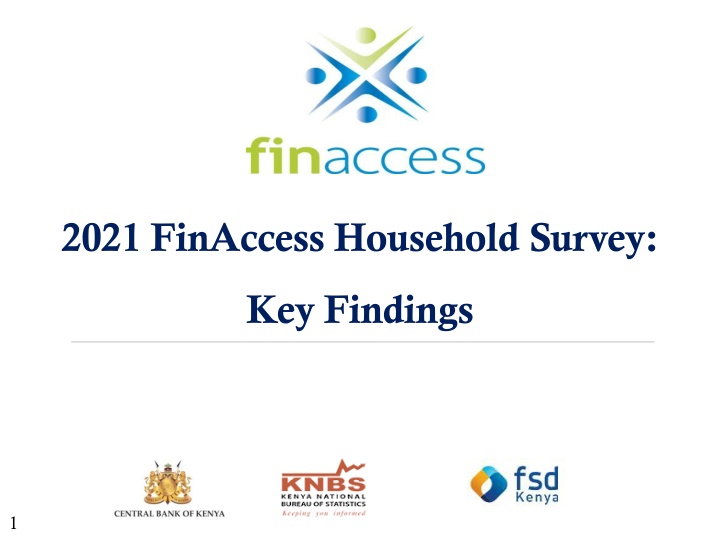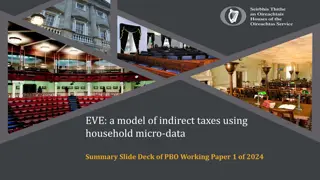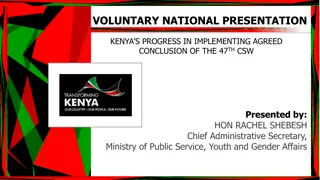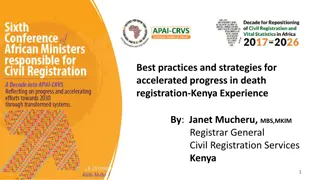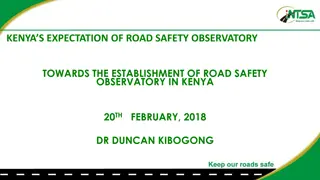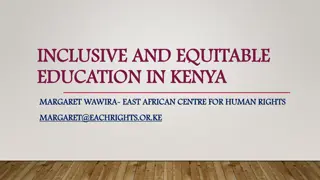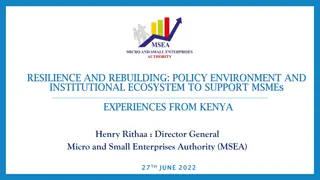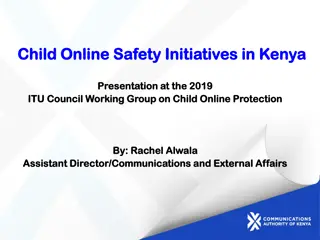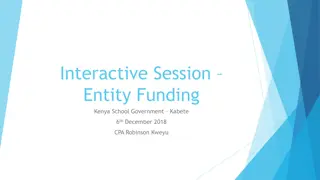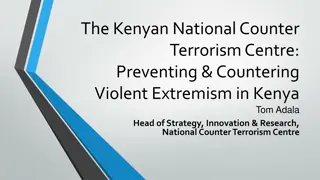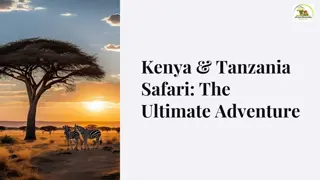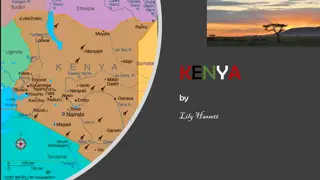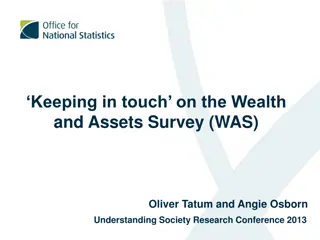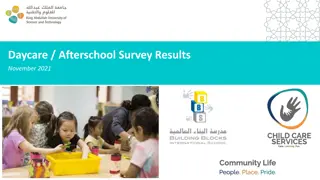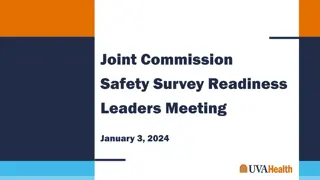Insights from the 2021 FinAccess Household Survey in Kenya
The 2021 FinAccess Household Survey in Kenya delved into key aspects of financial inclusion, focusing on dimensions like access, usage, quality, and impact. With a sample size of 30,600 households across national, rural, and urban domains, the survey highlights demographic trends and key findings on financial behavior. Conducted through Computer Aided Personal Interviews (CAPI), the survey provides valuable insights to inform financial policies and programs in Kenya.
Download Presentation

Please find below an Image/Link to download the presentation.
The content on the website is provided AS IS for your information and personal use only. It may not be sold, licensed, or shared on other websites without obtaining consent from the author.If you encounter any issues during the download, it is possible that the publisher has removed the file from their server.
You are allowed to download the files provided on this website for personal or commercial use, subject to the condition that they are used lawfully. All files are the property of their respective owners.
The content on the website is provided AS IS for your information and personal use only. It may not be sold, licensed, or shared on other websites without obtaining consent from the author.
E N D
Presentation Transcript
2021 FinAccess Household Survey: Key Findings 1
Presentation Flow Introduction Key Findings Summary and Next Steps Questions and Answers Session 3
INTRODUCTION Survey Methodology, Sample and Demographics 4
Methodology The 2021 FinAccess is a cross-sectional survey undertaken to provide indicators on financial inclusion from four measurement dimensions: Access; Usage; Quality; and Impact/Welfare Targeted persons aged 16 years and above living within conventional households in Kenya at the time of data collection Interviewees selected randomly 5
Survey Sample Study domains used: 50 i.e. National; Rural, Urban; and 47 Counties Sample size: 30,600 households Used the newly created Kenya Household Master Sample Frame (K-HMSF) based on the 2019 Kenya Population and Housing Census data Overall response rate: 85.6 percent 6
Survey Demographics Fig.: Age Distribution Fig.: Response rates 30 RESIDENCE 26.3 RESULTS 25.9 RURAL URBAN TOTAL 25 Selected Households Eligible Households Households Interviewed Response Rate (%) 18,774 11,826 30,600 20 16.5 Percent 15 13.4 16,316 9,408 25,724 10 10 7.9 14,455 7,569 22,024 5 88.6 80.5 85.6 0 16-17 yrs 18-25yrs 26-35yrs 36-45yrs 46-55yrs >55yrs 7
Survey Demographics Fig.: Population by Sex Fig.: Population by Residence 8
Survey Administration The survey used Computer Aided Personal Interview (CAPI) through face-to-face interviews; in English, and translations in several local languages, with Kiswahili being the most preferred interview language KNBS cleaned and weighted the data to total population, representing those aged 16+ years 9
Key findings Access Usage Quality Impact
Access to formal financial services providers rose to 83.7 % in 2021 but those accessing informal providers declined further. The excluded population was11.6% in 2021 from 11% in 2019 Overall access levels Fig.: Access by Categories Fig.: Access Trends 2006:2021 12
Overall, number of those who Used to Have certain products/services increased in 2021 compared to 2019 13
Youths and the elderly above 55 years largely explain increased exclusion rate. Those aged 18 25 years most excluded at 22.5% in 2021, up from 18.2% exclusion rate in 2019. Fig.: Exclusion Rates by Age in 2021 (Percent) 14
The gap between male and female improved to 4.2% in 2021 from 8.5 percent in 2016, implying rising equality among the two genders in terms of formal inclusion. Fig.: Included Vs Excluded by Sex (Percent) 15
Slow growth in mobile money uptake - only by 2 percentage points growth in 2021 2019 compared to 33.7 percentage points in 2013 2009. May explain overall slow growth in inclusion Fig: Slow Growth of Mobile Money Uptake Survey Year 2006 2009 2013 2016 2019 2021 Uptake (Percent) Base year 27.9 61.6 71.4 79.4 81.4 Change in Percentage Point Base year 27.9 33.7 9.8 8 2 16
In addition, income disparities (measured by wealth quintiles), age, and residence appear to explain the marginal uptick in exclusion rate in 2021. Fig.: Exclusion by Demographics Highest 3.6 Second Highest 7.8 Middle 10.8 Second Lowest 16.2 Lowest 25.0 Urban 6.2 Rural 14.7 >55yrs 14.9 46-55yrs 6.5 36-45yrs 5.3 26-35yrs 5.2 18-25yrs 22.5 Female 12.4 Male 10.8 17
Significant variation in formal financial access across counties Formal inclusion by County 18
Financial exclusion is determined by various socio-economic factors? Exclusion levels by County 19
Deepening Usage: Providers, Services and Products We are interested in measuring; How frequent people actually use these providers, services or products How long (duration) people take using these financial providers, services and products Reasons for use or non-use of certain providers, services or products We analyse the providers, products and services along key demographic indicators - age, sex, education, residence, wealth quintile and County Since the respondents use these providers and products in multiples, proportions of usage are not additive
Mobile money and mobile banking usage includingFuliza are driving financial inclusion. Decline in Digital Apps Loans may reflect competition from the regulated digital credit providers and unfair debt collection practices that scare potential users . Fig.: Usage of Financial Services and Products by Providers (Percent) Usage of all the non-bank related providers declined in 2021, an area of deep dive research 21
Increased frequency of mobile money and informal groups usage in 2021 may indicate increased liquidity needs, government policy to curb the spread of COVID-19 in 2020, and waiver of transaction charges Fig.: Usage of Financial Providers by Frequency Frequency of Usage 22
Consumers use a portfolio of financial providers, services and products in terms of formal and informal in order to meet their needs Fig.: Usage by Combination of Financial services providers More is preferred to less.... 23
Mobile money including Fuliza usage continues to drive narrowing gap between male and female users however more female than male use informal sources/products Fig.: Usage of Financial Providers and Products by Sex Frequency of Usage 24
Traditional banking (brick and mortar) usage continue to decline since 2016 as more people embrace Mobile banking across all demographics Female and rural residents adopting mobile banking faster improved infrastructure (including cheaper smart phones), convenience, Fig.: Traditional versus Mobile Banking Usage Overtime by Demographics 25
Lack of money to save, no regular income and high cost of operating a bank account cited as main reasons why people have not used bank account in the last 12 months prior to the survey Fig.: Reasons for Not Using Bank Account Savings vs Credit Usage 26
Actual usage of all non-bank financial providers, services and products, except for Insurance regulated by IRA, declined in 2021. Even the use of NHIF declined despite the recent initiatives may be due to COVID-19 related restrictions and their impact Insurance, Pension and Investments Fig.: Insurance, Pension and Investments Usage Trends 27
Usage of Chamas/Groups and Family/Neighbours/ friends increased in 2021, highlighting the important role of social networks in financial inclusion at household level Use of secret hiding places and shopkeepers declined marginally Fig: Breakdown in Informal Group over time 28
Use of Cash followed by mobile money dominate all transactions channels in 2021 compared to 2019 2019 2021 100.0 Monthly bills 89.4 90.0 School fees 80.0 Govt bills 70.0 Pension 60.0 Daily Expenses 39.5 42.2 50.0 Sent money within 44.7 38.0 40.0 Sent money outside Received money within Received money from outside Paid for Assets 30.0 1.7 20.0 0.3 10.8 10.0 0.3 0.0 Bank Transfer Mobile money cash Pay bill/Till No. 29
A majority of Kenyans use both cash and non-cash across all types of transactions. Exclusive use of non-cash quite marginal, at below 1 percent The Questionnaire did not ask about cash limits. Proposal for a follow up tracker survey on digitization 30
Mobile money usage is the equalizing factor across Counties by provider and product Usage of different providers seem to follow economic and socio-cultural orientation of counties Usage of Financial Services and Products by County Usage by County 31
Theme: Addressing quality concerns in the era of financial digitalisation and misinformation The objective is to measure whether the financial products and services match clients needs, the range of options available to customers, and clients awareness and understanding of financial products by focussing on financial literacy and consumer protection concerns. 33
Financial Literacy Majority of Kenyans seek financial advice from informal sources family and friends and personal knowledge/experience Fig.: Sources of financial advice (%) 45.0% of adults rely on friends and family for financial advice 43.3% rely on their own knowledge for financial advice 34
The survey tested the ability of respondents to accurately compute a 10 percent interest on a KSh 10,000 loan: 49.3% of the adult population got correct answer 66.3% correctly identified transaction costs on a mobile phone Knowledge about Cost of Borrowing Knowledge about Transaction costs 35
More respondents reported increased Unexpected/unclear charges in 2021 compared to 2019. Other major challenges: frequent system downtime, poor customer service and lost money from account Fig.: Challenges cited by Consumers in 2021 by Provider (percent Fig: Unexpected or unclear charges 36
We also analyse the household indebtedness. We noted that debt distress is a major challenge affecting consumers in 2021, with 10.7% of borrowers completely defaulting (did not pay at all) on their loans Fig.: Default by Type 37
About 14.4% of respondents with existing loan from a bank, MFBs or SACCOs in 2020/201 applied for loan restructuring, with close 77 percent being successful (a) Requested for restructuring (b) Loans Were Restructured 38
Strategies employed by households in debt repayment and resolving household indebtedness in 2021 ... Cut down on other expenses (food and non-food), ran down savings, looked for additional work/business and took another loan to repay Fig.: Strategies Employed to Repay Debt 39
Those who perceive betting as a good source of income halved in 2021, a majority being female respondents people also bet less frequently and amount per bet has reduced. (a) Those Perceiving Betting a good source of income (b): Frequency of betting 40
Impact dimensions Dividends of inclusive finance for enhanced Sustainable Financial Health 41
Putting food on the table was a key life priority for Kenyans, with overall food vulnerability increasing in 2021 12% of respondents reported that they often slept without food in 2021 Life Goals Food Vulnerability Life priorities 35.5 31.8 67 2019 2021 30.2 28.5 58.1 50.7 46.5 16.1 15 41.2 40.9 13.2 35.8 9.3 8.9 26 12.3 Education Putting food on the table Improving livelihood source/ developing your career Health Getting a job 8.4 8 6.1 2013 2016 2019 2021 42
The number of respondents who reported financial needs to deal with a shock increased 67.1% in 2021 from 36.2 % in 2019 the main shock being health related Financial needs Shocks in 2019 vs 2021 Financial needs Goals 21.4 67.1 Major health problem 31.8 62.5 62.1 59.9 59.2 Loss of income 23.0 10.9 36.2 Death of a relative 20.2 Pest/ diseases (locust) 8.9 4.4 Theft/violence 4.1 Death of main income earner 2 3.4 Meeting every day to day needs Experienced shocks Meeting future goals 2019 2021 2019 2021 43
Use of formal solutions declined by almost half in meeting all 3 financial needs Decline in use of informal solutions in dealing with day to day needs and shocks but increased for future investments Meeting day to day needs Dealing with shocks Investing in the future Meeting needs 0 5.2 5.6 10.2 11.1 15 17.7 39.3 36 26.8 16.9 42.8 43.1 13.3 17.7 29.3 6.9 6.8 60.1 48.8 40.2 42.9 35 29.3 2019 2021 *2019 *2021 2019* 2021* 44
Overall, financial health index declined in 2021compared to 2019, mainly on account of inability to meet day to day needs and coping with shocks. There is however optimism about investing more for their future. Financial health and Optimism Financial health index Perception towards financial situation 63 55.3 73.6 52.4 46.5 45.0 39.5 39.4 36.9 51 38.2 23.3 21.8 21.7 34.3 17.1 27.5 24.8 23.8 18.1 7.4 Ability to manage day to day Ability to cope with risks Ability to invest in livelihoods and the future Overall financial health score Improved Remained the same Worsened 2016 2019 2021 2016 2019 2021 45
Summary and Conclusions The 2021 FinAccess Survey provide very rich data and indicators for tracking developments in the financial inclusion space in terms of changing consumer behaviour, technological innovations, policy changes, demographic dynamics, entry of new players as well as globalization of economies. Expanding the scope of the survey to all access, usage, quality and impact/welfare dimensions provide a holistic view to inclusive finance We welcome more in-depth research from academia, development partners, private sector and policy makers in order to guide policy solutions, provide new knowledge and influence innovations that would benefit consumers 46
Thank You! 47
